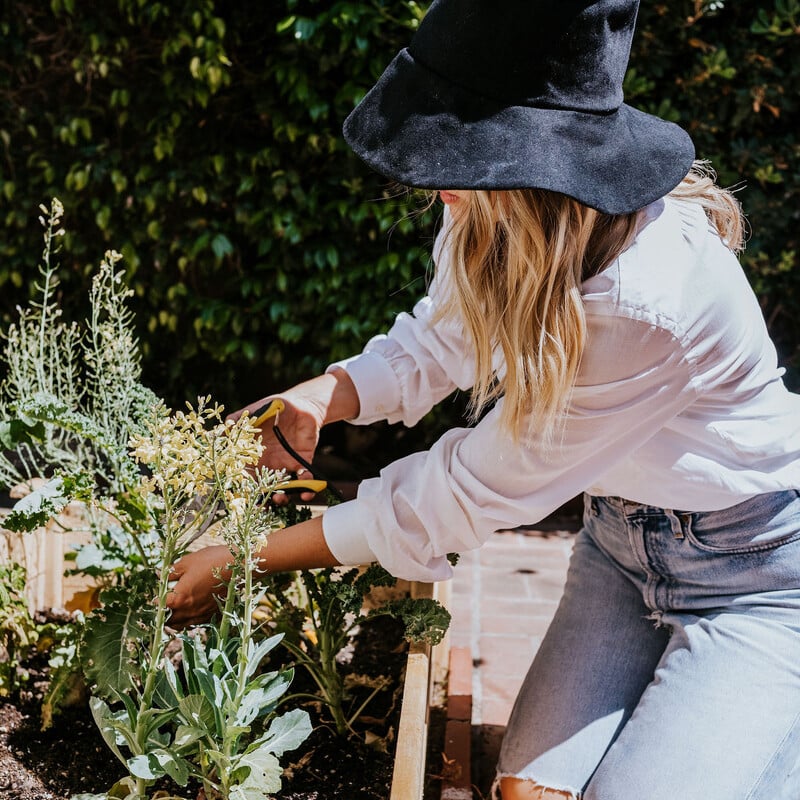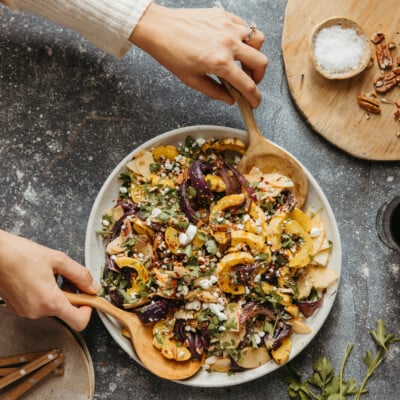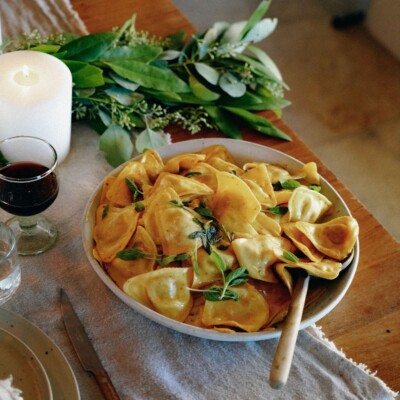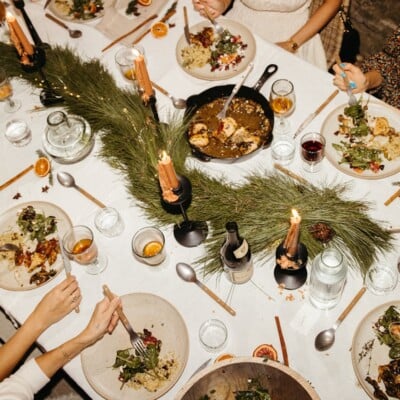Fact: you don’t need a big space or an actual garden patch to grow your own fruits and vegetables. Many think a sprawling backyard is required to grow herbs, veggies, and produce, but all you really need are a few large pots and some decent sun exposure to get your container garden growing. So whether you’re building raised garden beds or simply looking to fill a few vessels on your back deck, consider this your ultimate guide to container gardening for beginners.
There are so many varieties of vegetables that thrive in containers. And when it comes to your garden’s design, the options are endless. This can look like anything from pots on your patio to window boxes outside your kitchen window. Even if your outdoor space is slim to none, there’s still something you can grow in a container garden.
Featured image from our interview with Janessa Leoné by Teal Thomsen.

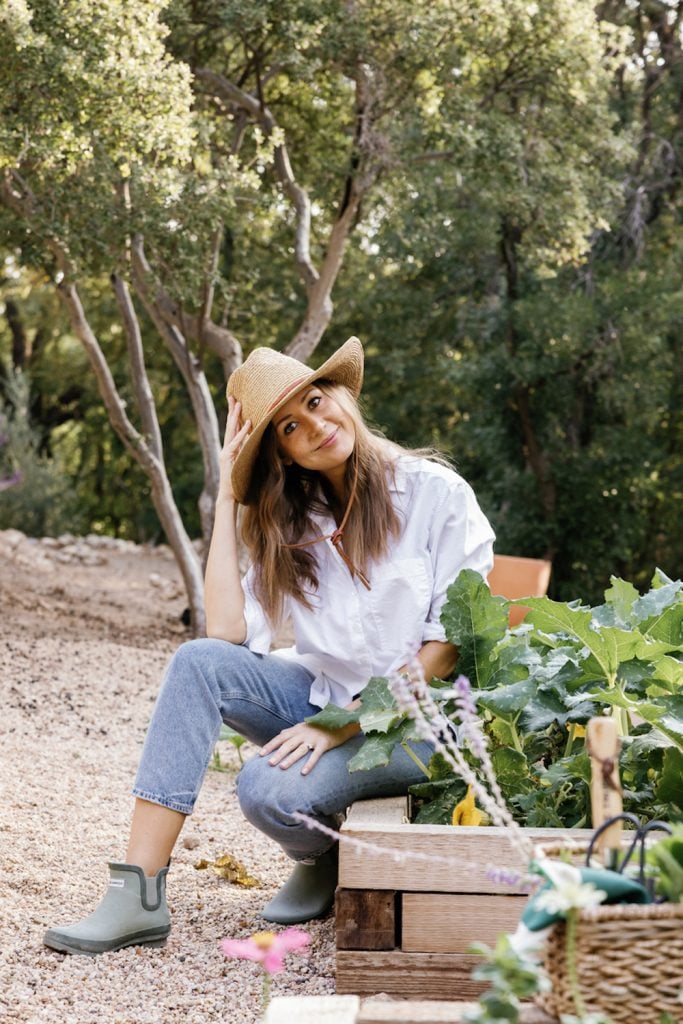
Container Gardening for Beginners
Some of the easiest vegetables to grow in containers are nightshades like tomatoes, potatoes, peppers, and eggplant, as well as fast-growing crops like peas and lettuce. Of course, there is no such thing as foolproof vegetable gardening, but container vegetable gardening comes close by reducing the threats posed by bad weather, pests, and hungry critters.
Growing vegetables in containers is an easy way to enjoy fresh food without the hassles of pulling weeds or tilling the soil. All you need is a pot, good soil, and sun! Ahead, in this guide to container gardening for beginners, we’re breaking down eight fruit and vegetable varieties you should start with. You’ll truly be amazed at what you can grow in a small space!
Herbs
First on the list: kitchen herbs. Kitchen herbs are the easiest edible plants to grow and deserve a spot on any container garden list. For the rookie gardener, planting fresh herbs is a great way to begin testing out your green thumb, and unlike succulents or shrubs, succeeding with these plants is extra gratifying, as they work wonders in elevating your cooking game as well.
Try thyme, chives, mint, sage, parsley, oregano, and rosemary outdoors, and basil and coriander on the kitchen windowsill. Check out this post for more info on planting herbs and amazing recipes to make with each one!

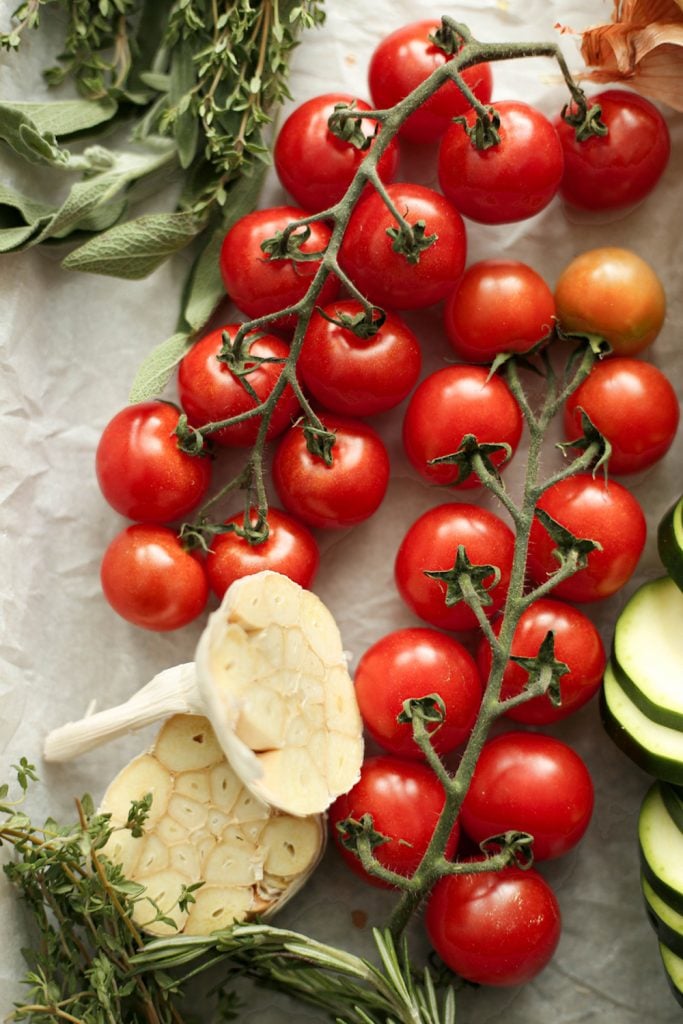
Tomatoes
Growing tomatoes in containers are easy and incredibly satisfying. You can grow tomatoes in pots, grow bags, and even hanging baskets, but most tomatoes also are happiest in big containers and will need staking or a tomato cage (this extra support keeps the heavy fruit from bending and breaking the vines.)
Tomato Planting Tips:
- If you are buying tomato seedlings, look for short, stocky plants that do not have blossoms yet.
- Tomatoes do not like the cold, so do not put them out too early. If planting outside, make sure you harden off or gradually acclimate seedlings to outside living before you plant them.
- When planting tomato seedlings, plant them deeply—much deeper than you do most plants. They will thrive in deep, moist soil with good drainage. Stick to one plant per pot.
- Keep dogs and cats away from this plant, as the leaves are toxic if ingested by pets.
Summer Squash
Zucchini (also called summer squash) is a great vegetable for small-space gardeners. It’s nearly guaranteed to grow, it produces tons of veggies all summer long, and comes in lots of fun shapes and colors. Grow compact varieties like Gold Rush yellow zucchini, Spacemiser green zucchini, or Sunburst scallopini zucchini.
Summer Squash Planting Tips:
- Plant one plant per 15-gallon pot, or two plants in pots 20 inches or more across.
- Ideal growing conditions include lots of light (full sun is best), good, rich soil as well as consistent watering and feeding.

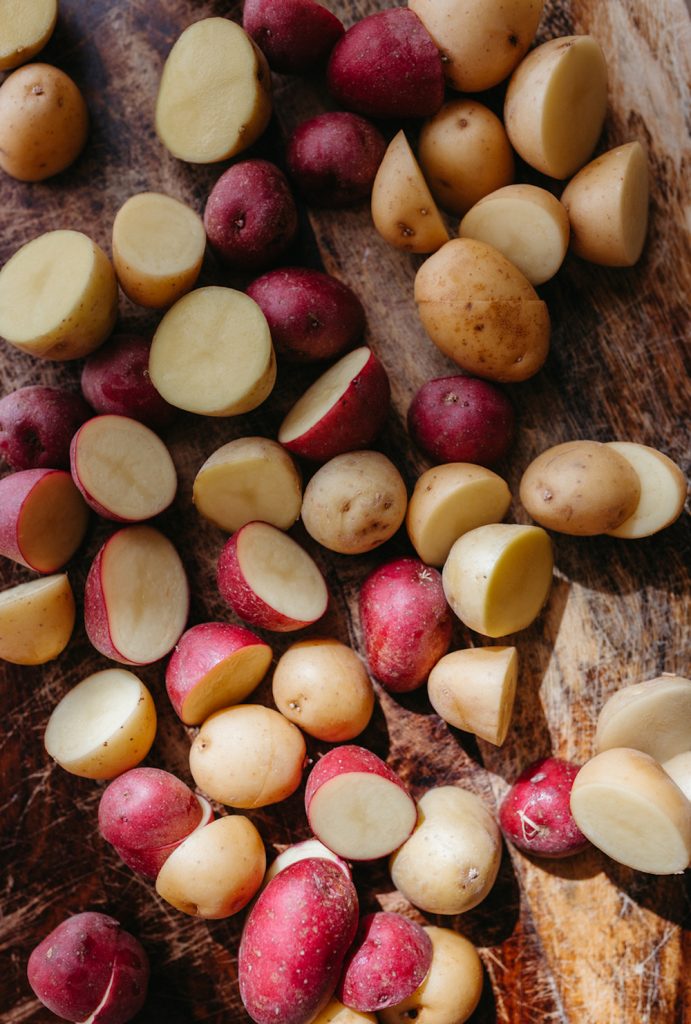
Potatoes
Did you know that freshly picked potatoes taste entirely different than the potatoes you would buy in a grocery store? They have higher water content and a bitter, earthy flavor that pairs so well with other fresh ingredients. Many people think potato plants need lots of room to grow, but what they actually need is deep soil. They will grow just fine in long containers like barrels or plastic dustbins. Even though growing potatoes require a lot of soil and water, it is well worth the effort to take your tasty spring and summer recipes to the next level.
Potato Planting Tips:
- Potatoes are productive if there’s ample room for tubers to develop. Bury seed potatoes in an 8-inch layer of soil at the bottom of the pot, six inches apart from each other.
- As plants grow, pile more soil up to the top set of leaves.
- I recommend trying small to medium-sized potatoes at first—All Blue, Red Pontiac, or Yukon Gold potatoes are a safe bet for beginners.
Radishes
Crispy, peppery radishes are great in salads and a good crop for beginner vegetable gardeners. They are trouble-free and grow ridiculously quickly—most go from seed to harvest in just about a month. They also do not need much space—they can grow in containers that are four to six inches deep, so they’re perfect for someone who lives in an apartment. There are many varieties, which means you can select your seeds based on appearance and flavor. I think radishes are so gorgeous—a fresh and instant decor boost to your kitchen! The tops of radish greens are also edible, as are the pods.
Radish Planting Tips:
- Sow seeds about 1 centimeter deep and at least an inch apart. Do this little and often between March and August for a continuous supply of radishes.
- Keep cool and water well. These plants do not like getting too hot, but you can control this easily by moving the plant into the shade or adding water to cool them down.
- Harvest after about a month before they mature and become woody.

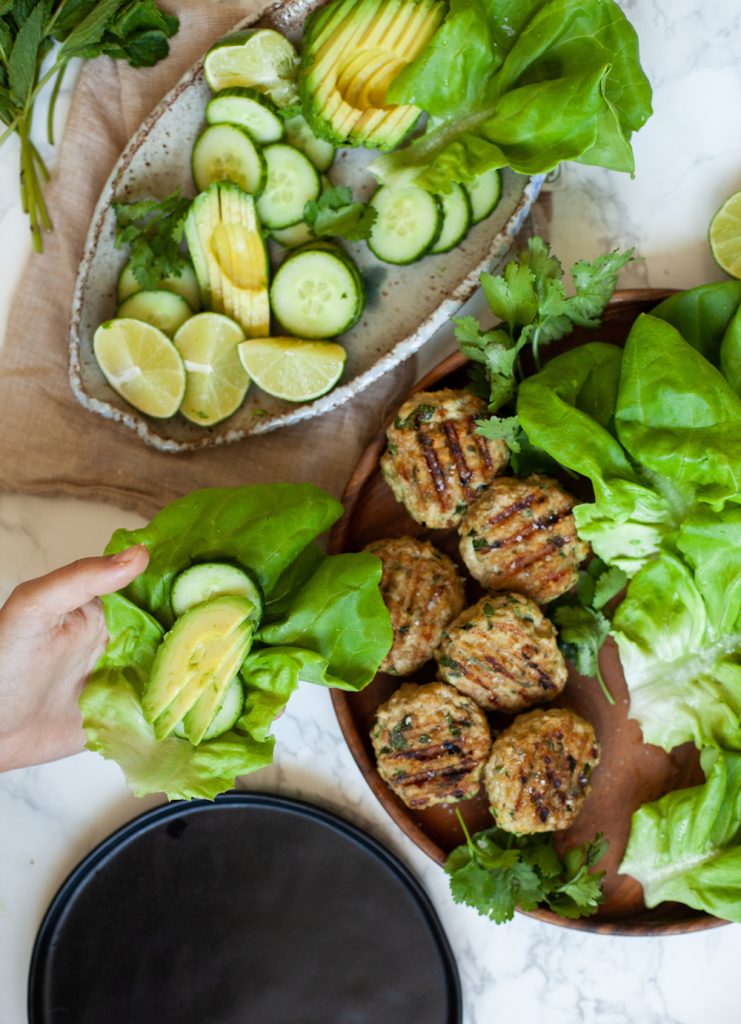
Lettuce
Growing lettuce and other salad greens in containers is fast and perfect for tiny spaces. You can even make your own vertical lettuce garden which looks so beautiful out on a patio. If you’re a big salad eater, you will love growing your own fresh lettuce and whipping up delicious recipes all summer. There are some great salad greens and mesclun mixes you can buy for container gardens that taste delicious and look good in decorative pots.
Lettuce Planting Tips:
- Sow one or two seeds in a pot less than an inch deep, at intervals so they don’t all mature at the same time.
- You need rich soil that is kept really moist for lettuces to grow well. Lettuce does not need as much sunlight as other vegetables, so find a place that gets a few hours of sun a day, preferably in the morning as the afternoon sun can scorch the plants depending on how hot it gets in your area.
- Water in the morning rather than the evening, and cut the head when the firm heart has formed.


Peppers
Peppers can be spectacularly beautiful, especially orange and purple sweet peppers in containers. Perfect for adding a sweet or fiery kick to a multitude of dishes, both hot and sweet peppers thrive in grow boxes, but can be grown in any large container with plenty of sun, good drainage, and consistent watering. Dry soil or overly wet soil is disastrous for peppers. And, the warmer the conditions are, the spicier the chilies!
Pepper Planting Tips:
- Planting bell pepper in containers requires a pot that is at least 10-12 inches deep and wide and has sufficient drainage holes. You can grow up to 2-3 plants (smaller varieties) per container, or one larger plant per container.
- Peppers love the sun. The most productive pepper plants are grown in warmth and heat, so keep them in a position that receives at least six hours of sunlight daily. Make sure they’re sheltered from strong winds.
- Good soil is the key to productive pepper plants. Buy the best quality potting mix that is well-drained, loose, and fertile, or make your own potting mix.
- Growing bell peppers requires regular watering to keep the soil slightly moist, and the soil should never dry out completely. Water at the foot of the plant. Pepper plants also suffer from overwatering, so be careful that your plants don’t sit in water.
Cucumbers
Cucumbers are a fast-growing vegetable commonly grown in containers. These water-loving plants do best in large plastic or ceramic pots that help the soil retain moisture. Growing cucumbers in containers is a great way to give them the heat they love and need to thrive. There are two main types of cucumbers: bush and vining. Either can grow in a container. Bush cucumbers tend to be shorter with smaller yields. The six to eight-inch long fruits have smooth, tender skin and sweet, crisp flesh. Vining cucumbers will require a trellis or tomato cage.
Cucumber Planting Tips:
- Plant one plant per 12-inch pot, or 2 plants in a larger container that’s at least 18 inches across.
- For larger planters, grow plants at final spacing of eight to 10 inches apart.
- They need heat and do best in a place with full sun to partial shade in the afternoon.
- Grow in a pot that has good drainage, filled with moist, fertilizer-enriched soil.


